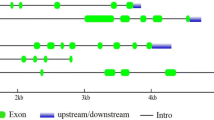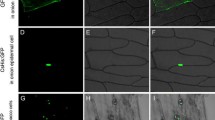Abstract
We have optimized and improved the protocol for extraction of histone proteins from Gossypium herbaceum. Histone proteins were isolated by acid extraction method and fractionation of histone proteins were performed using RP-HPLC (reverse-phase high performance liquid chromatography). Analysis of histones from drought tolerant (Vagad) and drought sensitive genotype (RAHS-14) indicated that the tolerant genotype Vagad encodes a 29 kDa protein. Protein sequencing on MALDI TOF/TOF revealed that the 29 kDA protein shared sequence similarity with another drought-inducible linker histone-H1.S reported in tomato. This H1.S like linker histone was not found in RAHS-14 in our study. We further examined the expression of H1 variant at the transcript and protein levels and found that it was induced specifically in the tolerant genotype Vagad.






Similar content being viewed by others
Abbreviations
- RP-HPLC:
-
Reverse-phase high performance liquid chromatography
- w/v:
-
Weight/volume
- Tris:
-
Tris (hydroxymethyl) aminomethane
- EDTA:
-
Ethylenediaminetetraacetic acid
- SDS-PAGE:
-
Sodium dodecyl sulphate–polyacrylamide gel electrophoresis
- PVDF:
-
Polyvinylidene difluoride
- MALDI-TOF:
-
Matrix-assisted laser desorption/ionization- time-of-flight
- RT-PCR:
-
Real-time PCR
References
Trivedi I, Rai KM, Singh SK, Kumar V, Singh M, Ranjan A, Lodhi N, Sawant SV (2012) Methods Mol Biol (Clifton, NJ) 833:225–236
Ahmad K, Henikoff S (2002) Mol Cell 9:1191–1200
Redon C, Pilch D, Rogakou E, Sedelnikova O, Newrock K, Bonner W (2002) Curr Opin Genet Dev 12:162–169
Shen X, Gorovsky MA (1996) Cell 86:475–483
Bouvet P, Dimitrov S, Wolffe AP (1994) Genes Dev 8:1147–1159
Ascenzi R, Gantt JS (1997) Plant Mol Biol 34:629–641
Bray EA, Shih TY, Moses MS, Cohen A, Imai R, Plant AL (1999) Plant Growth Regul 29:35–46
Scippa GS, Di Michele M, Onelli E, Patrignani G, Chiatante D, Bray EA (2004) J Exp Bot 55:99–109
Wei T, O’Connell MA (1996) Plant Mol Biol 30:255–268
Bray EA (2002) Ann Bot 89:803–811
Cellier F, Conéjéro G, Breitler JC, Casse F (1998) Plant Physiol 116:319–328
Seki M, Narusaka M, Ishida J, Nanjo T, Fujita M, Oono Y, Kamiya A, Nakajima M, Enju A, Sakurai T (2002) Plant J 31:279–292
Shinozaki K, Yamaguchi-Shinozaki K (1996) Curr Opin Biotechnol 7:161–167
Shinozaki K, Yamaguchi-Shinozaki K (2000) Curr Opin Plant Biol 3:217–223
Ingram J, Bartels D (1996) Annu Rev Plant Biol 47:377–403
Nakashima K, Ito Y, Yamaguchi-Shinozaki K (2009) Plant Physiol 149:88–95
Bray EA (1997) Trends Plant Sci 2:48–54
Ranjan A, Nigam D, Asif M, Singh R, Ranjan S, Mantri S, Pandey N, Trivedi I, Rai KM, Jena SN, Koul BN, Tuli R, Pathre UV, Sawant SV (2012) BMC Genomics 13(1):94
Xiong L, Wang RG, Mao G, Koczan JM (2006) Plant Physiol 142:1065–1074
Van Der Weele CM, Spollen WG, Sharp RE, Baskin TI (2000) J Exp Bot 51:1555–1562
Hoagland DR, Arnon DI (1950) Circ Calif Agric Exp Stn 347:1–32
Langenbuch J, Philipps G, Gigot C (1983) Plant Mol Biol 2:207–220
Muller A, Philipps G, Gigot C (1980) Planta 149:69–77
Thomas JO, Kornberg RD (1975) FEBS Lett 58:353–358
Laemmli UK (1970) Nature 227:680–685
Murray K (1966) J Mol Biol 15:409–419
Gurley LR, Valdez JG, Prentice DA, Spall WD (1983) Anal Biochem 129:132–144
Shinozaki K, Yamaguchi-Shinozaki K, Seki M (2003) Curr Opin Plant Biol 6:410–417
Ascenzi R, Gantt JS (1999) Plant Mol Biol 41:159–169
Ascenzi R, Gantt JS (1999) Chromosoma 108:345–355
Kahn TL, Fender SE, Bray EA, O’Connell MA (1993) Plant Physiol 103:597–605
Quisenberry JE, McMichael BL (1991) Environ Exp Bot 31:453–460
Kreps JA, Wu Y, Chang HS, Zhu T, Wang X, Harper JF (2002) Plant Physiol 130:2129–2141
Lipavská H, Vreugdenhil D (1996) Plant Cell Tissue Organ Cult 45:103–107
Acknowledgments
This work was supported by a research grant received from the Council of Scientific and Industrial Research (CSIR), Government of India. IT and AR acknowledge CSIR for research fellowship.
Author information
Authors and Affiliations
Corresponding author
Electronic supplementary material
Below is the link to the electronic supplementary material.
Rights and permissions
About this article
Cite this article
Trivedi, I., Ranjan, A., Sharma, Y.K. et al. The Histone H1 Variant Accumulates in Response to Water Stress in the Drought Tolerant Genotype of Gossypium herbaceum L.. Protein J 31, 477–486 (2012). https://doi.org/10.1007/s10930-012-9425-6
Published:
Issue Date:
DOI: https://doi.org/10.1007/s10930-012-9425-6




